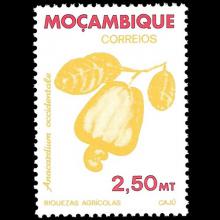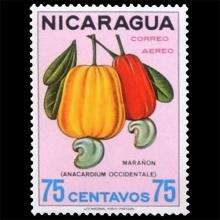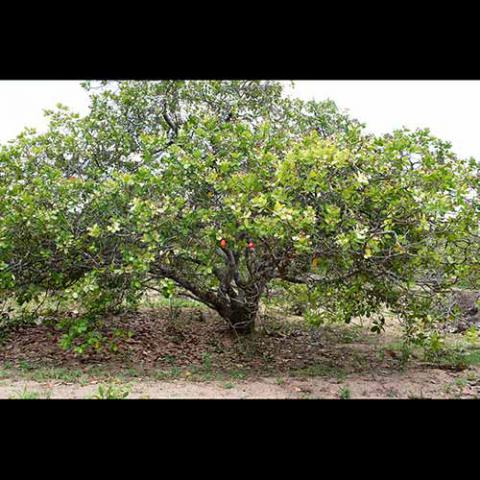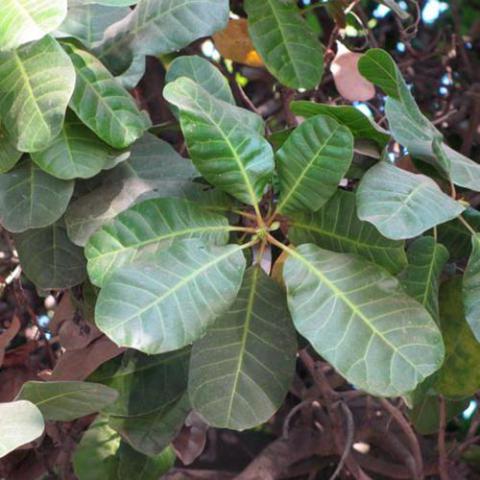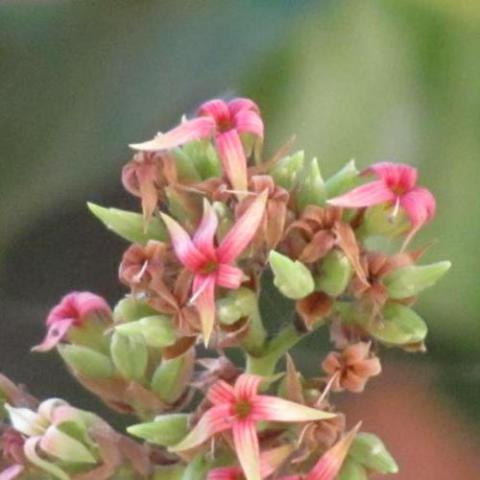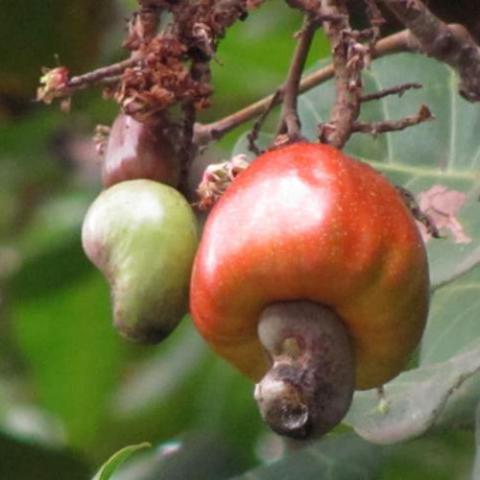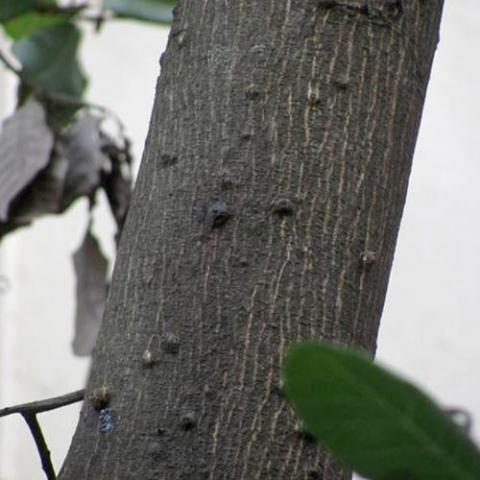NAME(S)
TAXONOMY
PLANTAE ID
THERAPEUTIC
Mozambique
Issued:
Stamp:
Anacardium occidentale
Nicaragua
Issued:
Stamp:
Anacardium occidentale
Mozambique
Issued:
Stamp:
Anacardium occidentale
Nicaragua
Issued:
Stamp:
Anacardium occidentale
Mozambique
Issued:
Stamp:
Anacardium occidentale
Nicaragua
Issued:
Stamp:
Anacardium occidentale
Genus species (Plantae): Anacardium occidentale
The cashew tree (Anacardium occidentale) is a tropical evergreen tree that produces the cashew seed and the cashew apple pseudofruit. The tree can grow as high as 14 m (46 ft), but the dwarf cultivars, growing up to 6 m (20 ft), prove more profitable, with earlier maturity and greater yields.
The cashew seed is often considered a nut in the culinary sense; this cashew nut is eaten on its own, used in recipes, or processed into cashew cheese or cashew butter. Like the tree, the nut is often simply called cashew. Culinary uses for cashew seeds in snacking and cooking are similar to those for all tree seeds called nuts. In 2017, Vietnam, India, and the Ivory Coast were the major producers. Cashew allergies are triggered by the proteins found in tree nuts, and cooking often does not remove or change these proteins. As well as the nut and fruit, the plant has several other uses. The shell of the cashew seed yields derivatives that can be used in many applications including lubricants, waterproofing, paints, and, starting in World War II, arms production. The cashew apple is a light reddish to yellow fruit, whose pulp can be processed into a sweet, astringent fruit drink or fermented and distilled into liquor.
Habitat and Growth
The species is native to Central America, the Caribbean, and northern South America, including northeastern Brazil. Portuguese colonists in Brazil began exporting cashew nuts as early as the 1550s. The cashew tree is native to northeastern Brazil, but the Portuguese took it to Goa, India between 1560 and 1565. From there, it spread throughout Southeast Asia, and eventually Africa.
The cashew tree is large and evergreen, growing to 14 m (46 ft) tall, with a short, often irregularly shaped trunk. The leaves are spirally arranged, leathery textured, elliptic to obovate, 4–22 cm (1.6–8.7 in) long and 2–15 cm (0.79–5.91 in) broad, with smooth margins. The flowers are produced in a panicle or corymb up to 26 cm (10 in) long; each flower is small, pale green at first, then turning reddish, with five slender, acute petals 7–15 mm (0.28–0.59 in) long. The largest cashew tree in the world covers an area around 7,500 m2 (81,000 sq ft) and is located in Natal, Brazil.
The fruit of the cashew tree is an accessory fruit (sometimes called a pseudocarp or false fruit). What appears to be the fruit is an oval or pear-shaped structure, a hypocarpium, that develops from the pedicel and the receptacle of the cashew flower. Called the cashew apple, better known in Central America as marañón, it ripens into a yellow or red structure about 5–11 cm (2.0–4.3 in) long. It is edible and has a strong "sweet" smell and taste.
The true fruit of the cashew tree is a kidney– or boxing-glove–shaped drupe that grows at the end of the cashew apple. The drupe develops first on the tree, and then the pedicel expands to become the cashew apple. The true fruit contains a single seed, which is often considered a nut in the culinary sense. The seed is surrounded by a double shell that contains an allergenic phenolic resin, anacardic acid—which is a potent skin irritant chemically related to the better-known and also toxic allergenic oil urushiol, which is found in the related poison ivy and lacquer tree.
Cashew nut and shell
Culinary uses for cashew seeds in snacking and cooking are similar to those for all tree seeds called nuts.
Cashews are commonly used in South Asian cuisine, whole for garnishing sweets or curries, or ground into a paste that forms a base of sauces for curries (e.g., korma), or some sweets (e.g., kaju barfi). It is also used in powdered form in the preparation of several Indian sweets and desserts. In Goan cuisine, both roasted and raw kernels are used whole for making curries and sweets. Cashews are also used in Thai and Chinese cuisines, generally in whole form. In the Philippines, cashew is a known product of Antipolo, and is eaten with suman. The province of Pampanga also has a sweet dessert called turrones de casuy, which is cashew marzipan wrapped in white wafers. In Indonesia, roasted and salted cashews are called kacang mete or kacang mede, while the cashew apple is called jambu monyet (lit. ‘monkey rose apple’).
In the 21st century, cashew cultivation increased in several African countries to meet the demands for manufacturing cashew milk, a plant milk alternative to dairy milk. In Mozambique, bolo polana is a cake prepared using powdered cashews and mashed potatoes as the main ingredients. This dessert is popular in South Africa.
In Brazil, cashew fruit juice and the fruit pulp are used in the production of sweets, juice, alcoholic beverages, such as cachaça, and as a flour, milk or cheese. In Panama, the cashew fruit is cooked with water and sugar for a prolonged time to make a sweet, brown, paste-like dessert called dulce de marañón (marañón being a Spanish name for cashew).
The shell of the cashew nut contains oil compounds that can cause contact dermatitis similar to poison ivy, primarily resulting from the phenolic lipids, anacardic acid, and cardanol. Due to the possible dermatitis, cashews are typically not sold in the shell to consumers. Readily and inexpensively extracted from the waste shells, cardanol is under research for its potential applications in nanomaterials and biotechnology.
Cashew Apple
The cashew apple, also called cashew fruit, is the fleshy part of the cashew fruit attached to the cashew nut. The top end of the cashew apple is attached to the stem that comes off the tree. The bottom end of the cashew apple attaches to the cashew nut, which is encased in a shell. In botanical terms, the cashew apple is an accessory fruit that grows on the cashew seed (which is the nut).
The cashew apple can be eaten fresh, cooked in curries, or fermented into vinegar, as well as an alcoholic drink. It is also used to make preserves, chutneys, and jams in some countries such as India and Brazil. In many countries, particularly in South America, the cashew apple is used to flavor drinks, both alcoholic and nonalcoholic.
Cashew nuts are more widely traded than cashew fruits, because the fruit, unlike the nut, is easily bruised and has a very limited shelf life. Cashew apple juice, however, may be used for manufacturing blended juices.
When consumed, the apple's astringency is sometimes removed by steaming the fruit for five minutes before washing it in cold water. Steeping the fruit in boiling salt water for five minutes also reduces the astringency.
In Cambodia, where the plant is usually grown as an ornamental rather than an economic tree, the fruit is a delicacy and is eaten with salt.
Reference: Wikipedia
Photos: Wikiwand.com,ramanarunachalam.github.io

